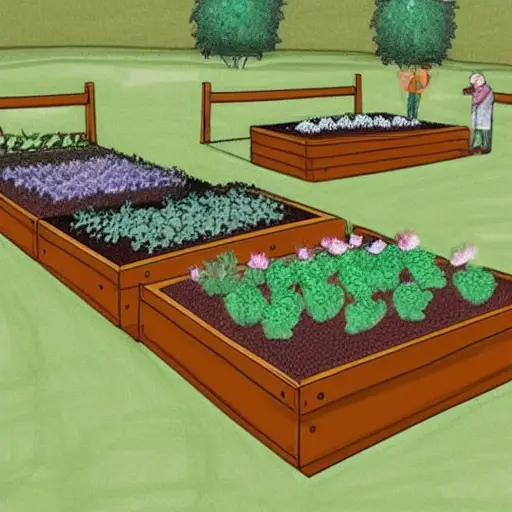Tomatoes
The first step to planting tomatoes in raised beds is to prepare the soil. Compost is a great help in retaining moisture and decomposing coarse materials in the soil. It also helps plants thrive by stimulating humus formation and soil life. Add compost to the top layer of soil and add wood chips or branches to the bottom layer. If you are growing tomatoes in the UK, it is best to acclimatise your plants for at least two weeks before planting them permanently outdoors.
Tomato plants should be spaced at least 24 inches apart to ensure proper health and fruit production. Different types of tomato plants require different spacing. Beginners often try to crowd their plants close together, which can result in diseases and pests. This practice will also reduce the amount of tomatoes you will produce. In addition, it may increase the risk of pests or diseases, which can lower their yield. Regardless of the variety you choose, you need to follow the recommended spacing to get the best results.
When planning for a tomato garden, ensure that you choose the right type of soil. In general, tomatoes require a minimum of one square foot of soil per plant. When planning for your planting, you should also determine the number of plants you want to plant in your raised bed. In order to figure out the number of plants to grow, you need to measure the area of each square foot.
Tomato plants will grow best in soil that is rich in organic matter. If your soil is a little sandy, make sure to add some organic matter. In addition, tomato plants will grow best if the soil is well-draining and packed with organic matter. If you don’t have these ingredients in your soil, you can purchase pre-made mixes for your raised beds.
Tomatoes grow best in warm soil. It is also best to harden off your tomato plants before planting them in your raised beds. This will help them tolerate a variety of temperatures.
Chard
If you want to grow chard in raised beds, you will want to use a raised bed with good drainage. You can plant chard seeds a half-inch deep about eight inches apart. After they’ve germinated, thin them to four to six inches apart. Chard grows best in full sun but can tolerate a little shade. Make sure the soil is well-drained and amended with compost or slow-release organic nitrogen fertilizer. This will promote vigorous growth of the tender leaves.
There are several varieties of chard. Five Color chard is one variety that has smooth, colorful leaves and is good for both cooking and salads. It can grow up to twenty inches tall and is a long-lived variety that can last for several years. Red Magic chard has deep red stems and is ready to harvest in 50 to 60 days. Rhubard chard has thick red stalks and red veins and is harvested in fifty to sixty-days.
Chard is a versatile vegetable that can be harvested at any stage of the growing season. Its leaves are edible and can be harvested throughout the summer and into the fall. Harvesting the outer leaves of Swiss chard will encourage the plant to grow new leaves. Harvesting the whole plant is best done before the last hard frost.
When planting chard, it is best to space plants according to their mature size. The plants should be spaced about one-quarter the way apart for the plants to grow properly. Also, be sure to keep the soil lightly moist. A mid-season side-dressing of manure or compost will nourish chard plants. If you do decide to fertilize chard with organic vegetable fertilizer, follow the instructions on the package.
Chard is one of the prettiest vegetables in the vegetable kingdom. It looks fantastic alongside annual flowers and ornamental plants. It also repels pests. Plants in the cabbage family are also good neighbors for chard because they have shallow roots and won’t compete for root space.
Courgettes
When planting courgettes in a raised bed, they are best planted in late May or early June, after the risk of frost has passed. They require a sunny spot, with soil that holds moisture well. Generally, they require one square metre of space per plant. To avoid the risk of disease, it is a good idea to space plants about 90cm apart, and plant one seed per growing bag. It is also important to amend the soil with compost or well-rotted manure, and to mulch the bed to conserve moisture. Young plants should also be protected from slugs and snails, so that they do not damage the growing process.
Courgette plants can be planted directly in the ground, but a raised bed offers more control. If you choose to plant them in a bed, you should prepare a watering can and place it at the foot of the plant. The foliage of the courgette should not be overly wet, as this can lead to fungal diseases. It is best to use rainwater, rather than tap water, and let it stand for 24 hours before watering.
To plant courgettes in a raised bed, you can start by preparing the soil. You can also add a compost or seedling compost to the soil. It is important to add plenty of organic matter, as this will help with the germination process. It is best to prepare the soil a few weeks before planting. Once the soil is moist, the first seedlings should appear after seven to ten days. A courgette plant can bear fruit in eight weeks, depending on the amount of time it spends in the soil.
While planting courgettes in a raised bed, you need to ensure that the bed has a thick layer of drainage. This can be done by using gravel or clay balls to help the soil retain water. You should also purchase potting soil specifically formulated for growing plants. The soil should also be enriched with organic matter to provide the plants with the nutrients and the right amount of water.
When planting courgettes, it is important to remember that the vegetable will grow big quickly, and you should pick them as soon as they reach a size that is convenient to eat. Ideally, you should harvest the courgettes when they are between ten and twenty centimeters. Leaving them longer will reduce their vigour and fruiting potential.
Squash
When planning how to plant squash in raised beds, it is essential to understand that they require more water than other vegetables. In a garden bed, you need to water only once or twice a week, while in a container you need to water your plants at least 1.5 times more frequently. It is also essential to monitor the moisture content of your soil regularly. You can do this by measuring the moisture level of the soil with a metal rod.
First, choose an area where your squash will receive ample sunlight. They need at least six hours of sunlight a day to grow, though more is best. During hot weather, the plants may droop, but they will perk up once the evening temperatures drop. Mulch your beds well, so that your soil retains moisture and discourages stem rot.
Next, remember that squash plants need both male and female flowers for pollination. Plant squash near other flowers so that pollinating insects will visit. The best time to hand pollinate your squash plants is when they are in their mid-season. To hand pollinate, use a paintbrush, toothbrush, or cotton swab. The male flower has a long stem, while the female has a budding fruit at its base.
You can plant squash in a raised bed or a container. The compact varieties will fit in your raised beds easily. However, winter squash will grow large and can occupy the entire garden. It is best to choose compact varieties and space them out strategically. You can also plant squash in front of peas, cucumbers, and tomatoes. To train your squash, you can use pea trellis or tomato cages.
Once the soil is ready, it is time to plant the squash plants. After you have prepared the ground, add some general purpose fertiliser to the soil. You can apply about two handfuls per square metre. After that, plant your squash seedlings in the middle of the hole. After a few days, thin the plants so that they are two or three in each hill.
Squash needs full sun, moist soil, and warm weather. It will grow rapidly and you must thin it regularly to make room for it. If you do not thin it, the plants may get too crowded and become diseased or pest-ridden. Some varieties are vining and can be trained up an arbor or sturdy trellis.







